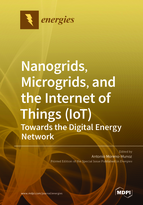Nanogrids, Microgrids, and the Internet of Things (IoT): towards the Digital Energy Network
A special issue of Energies (ISSN 1996-1073). This special issue belongs to the section "A1: Smart Grids and Microgrids".
Deadline for manuscript submissions: closed (22 January 2019) | Viewed by 32530
Special Issue Editor
Interests: internet of energy; smart grids; power quality; electronic instrumentation; usability of complex systems
Special Issues, Collections and Topics in MDPI journals
Special Issue Information
Dear Colleagues,
Driven by new regulations, new market structures, and new energy resources, the smart grid has been the trigger for profound changes in the way that electricity is generated, distributed, managed, and consumed. The smart grid has raised the traditional power grid by using a two-way electricity and information flow to create an advanced, automated power supply network. However, these pioneering smart grid technologies must grow to adapt to the demands of the current digital society.
In today’s digital landscape, we can access feasible data and knowledge that was merely inconceivable. This Special Issue aims to address the landscape in which smart grids are progressing, due to the advent of pervasive technologies like the Internet of Things (IoT). It will be the advanced exploitation of the massive amounts of data generated from (low-cost) IoT sensors that will become the main driver to evolve the concept of the smart grid, currently focused on infrastructure, towards the digital energy network paradigm, focused on service. Furthermore, collective intelligence will improve the processes of decision making and empower citizens.
Original manuscripts focusing on state-of-the-art IoT networking and communications, M2M communications, cyber–physical system architectures, big data analytics or cloud computing applied to digital energy platforms, including design methodologies and practical implementation aspects are welcome. The issue will include , but is not limited to:
- Nanogrids, Microgrids.
- Smart Energy communities, Smart buildings, Smart Appliances
- EMS, DSM/DR, HEM
- Power Quality and Reliability AMI (advanced metering infrastructures)
- Custom Power and Critical Loads Supply
- EV Charging Infrastructure
Prof. Dr. Antonio Moreno-Munoz
Guest Editor
Manuscript Submission Information
Manuscripts should be submitted online at www.mdpi.com by registering and logging in to this website. Once you are registered, click here to go to the submission form. Manuscripts can be submitted until the deadline. All submissions that pass pre-check are peer-reviewed. Accepted papers will be published continuously in the journal (as soon as accepted) and will be listed together on the special issue website. Research articles, review articles as well as short communications are invited. For planned papers, a title and short abstract (about 100 words) can be sent to the Editorial Office for announcement on this website.
Submitted manuscripts should not have been published previously, nor be under consideration for publication elsewhere (except conference proceedings papers). All manuscripts are thoroughly refereed through a single-blind peer-review process. A guide for authors and other relevant information for submission of manuscripts is available on the Instructions for Authors page. Energies is an international peer-reviewed open access semimonthly journal published by MDPI.
Please visit the Instructions for Authors page before submitting a manuscript. The Article Processing Charge (APC) for publication in this open access journal is 2600 CHF (Swiss Francs). Submitted papers should be well formatted and use good English. Authors may use MDPI's English editing service prior to publication or during author revisions.
Keywords
- Nanogrids
- Microgrids
- Smart Grids
- Internet of Things
- Big Data
- Power Quality
- Cloud computing
- Digital Utilities
- Digital Energy Network
- EMS
- DSM
- DR
- Power Quality and Reliability
- Custom Power
- Critical Loads Supply






